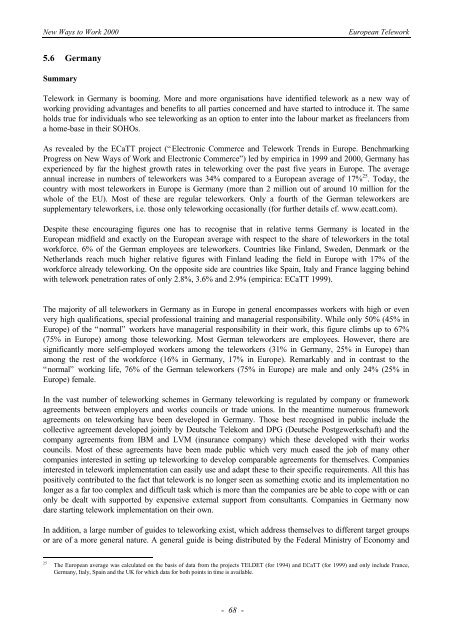eWORK 2000 - European Telework Week
eWORK 2000 - European Telework Week
eWORK 2000 - European Telework Week
- No tags were found...
You also want an ePaper? Increase the reach of your titles
YUMPU automatically turns print PDFs into web optimized ePapers that Google loves.
New Ways to Work <strong>2000</strong><strong>European</strong> <strong>Telework</strong>5.6 GermanySummary<strong>Telework</strong> in Germany is booming. More and more organisations have identified telework as a new way ofworking providing advantages and benefits to all parties concerned and have started to introduce it. The sameholds true for individuals who see teleworking as an option to enter into the labour market as freelancers froma home-base in their SOHOs.As revealed by the ECaTT project (“Electronic Commerce and <strong>Telework</strong> Trends in Europe. BenchmarkingProgress on New Ways of Work and Electronic Commerce”) led by empirica in 1999 and <strong>2000</strong>, Germany hasexperienced by far the highest growth rates in teleworking over the past five years in Europe. The averageannual increase in numbers of teleworkers was 34% compared to a <strong>European</strong> average of 17% 25 . Today, thecountry with most teleworkers in Europe is Germany (more than 2 million out of around 10 million for thewhole of the EU). Most of these are regular teleworkers. Only a fourth of the German teleworkers aresupplementary teleworkers, i.e. those only teleworking occasionally (for further details cf. www.ecatt.com).Despite these encouraging figures one has to recognise that in relative terms Germany is located in the<strong>European</strong> midfield and exactly on the <strong>European</strong> average with respect to the share of teleworkers in the totalworkforce. 6% of the German employees are teleworkers. Countries like Finland, Sweden, Denmark or theNetherlands reach much higher relative figures with Finland leading the field in Europe with 17% of theworkforce already teleworking. On the opposite side are countries like Spain, Italy and France lagging behindwith telework penetration rates of only 2.8%, 3.6% and 2.9% (empirica: ECaTT 1999).The majority of all teleworkers in Germany as in Europe in general encompasses workers with high or evenvery high qualifications, special professional training and managerial responsibility. While only 50% (45% inEurope) of the “normal” workers have managerial responsibility in their work, this figure climbs up to 67%(75% in Europe) among those teleworking. Most German teleworkers are employees. However, there aresignificantly more self-employed workers among the teleworkers (31% in Germany, 25% in Europe) thanamong the rest of the workforce (16% in Germany, 17% in Europe). Remarkably and in contrast to the“normal” working life, 76% of the German teleworkers (75% in Europe) are male and only 24% (25% inEurope) female.In the vast number of teleworking schemes in Germany teleworking is regulated by company or frameworkagreements between employers and works councils or trade unions. In the meantime numerous frameworkagreements on teleworking have been developed in Germany. Those best recognised in public include thecollective agreement developed jointly by Deutsche Telekom and DPG (Deutsche Postgewerkschaft) and thecompany agreements from IBM and LVM (insurance company) which these developed with their workscouncils. Most of these agreements have been made public which very much eased the job of many othercompanies interested in setting up teleworking to develop comparable agreements for themselves. Companiesinterested in telework implementation can easily use and adapt these to their specific requirements. All this haspositively contributed to the fact that telework is no longer seen as something exotic and its implementation nolonger as a far too complex and difficult task which is more than the companies are be able to cope with or canonly be dealt with supported by expensive external support from consultants. Companies in Germany nowdare starting telework implementation on their own.In addition, a large number of guides to teleworking exist, which address themselves to different target groupsor are of a more general nature. A general guide is being distributed by the Federal Ministry of Economy and25The <strong>European</strong> average was calculated on the basis of data from the projects TELDET (for 1994) and ECaTT (for 1999) and only include France,Germany, Italy, Spain and the UK for which data for both points in time is available.- 68 -








